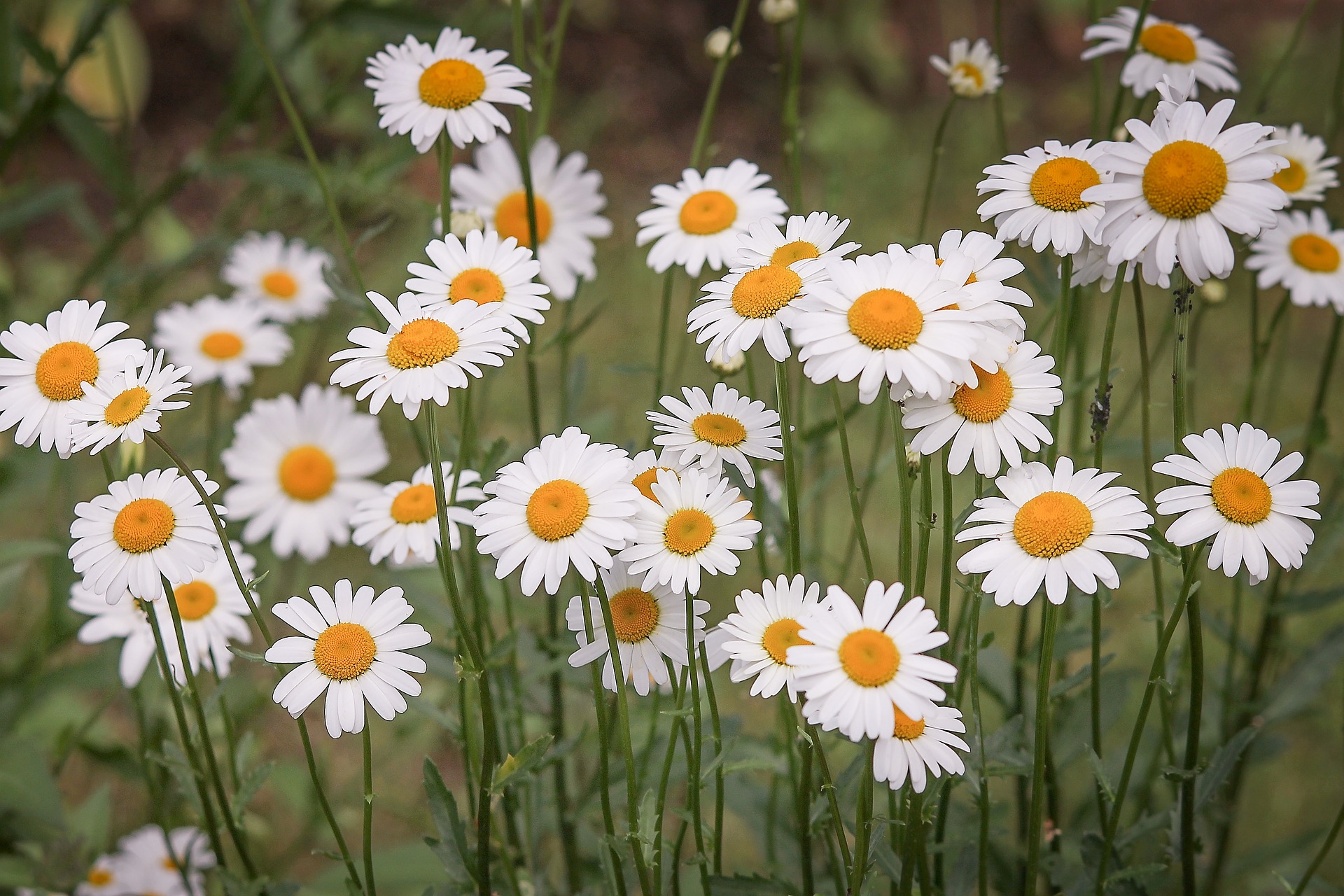
Marguerite, Leucanthemum: planting and care
Contents
Daisy in a nutshell
- It is the great hardy perennial daisy of our gardens, also known as leucanthemum!
- Its large, simple flowers, white with a yellow centre, possess the rustic charm that evokes the countryside so well.
- Particularly robust and resistant to diseases, it is perfectly hardy in all regions of France.
- It is a very easy-to-cultivate young plant that requires little: dry to moist soil and exposure to sun or partial shade.
- It will bring a decidedly rural touch to your flowerbeds, contemporary meadow gardens, or your summer to autumn bouquets.
A word from our expert
With its large white or yellow flowers with a yellow centre, the Leucanthemum or “Oxeye Daisy” is THE perennial plant essential for a natural garden, a grand mixed border, and cottage-style flower beds in country houses, to which it brings a wholesome charm. Once cherished in vicarage gardens, it is unmatched in brightening up and adding a touch of freshness to the garden with its large single or double heads.
With its slightly rustic charm that evokes the countryside so well, the Daisy combines simple grace with the hardiness and floribundity of wild plants. It is also one of the most beautiful cut flowers!
From the white Daisy (Leucanthemum ‘Aglaia’) to the yellow-flowered Daisy (Leucanthemum superbum ‘Sonnenschein’), from Leucanthemum maximum ‘Becky’ with large white flowers to Leucanthemum vulgare or Common Daisy, you can now find all types of daisies, from the simplest to the most fanciful.
Whether it is a summer daisy or an autumn daisy, all are low-maintenance perennials, easy to grow in any dry to moist soil in full sun or partial shade.
Particularly robust and perfectly hardy, the Daisy is timeless! Discover in our collection all the varieties of Daisies, from the most traditional to the most unique!
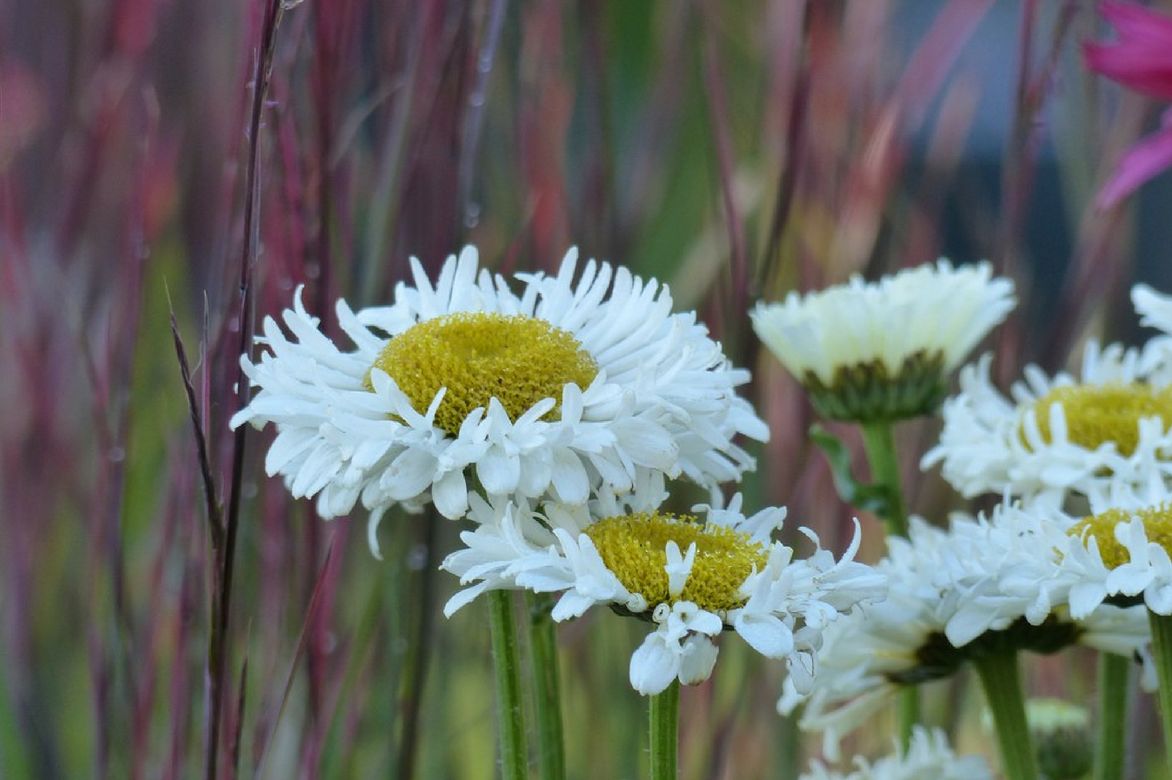
The rustic charm of daisies with large flowers.
Description and Botany
Botanical data
- Latin name Leucanthemum
- Family Asteraceae
- Common name Daisy, shasta daisy
- Flowering from May to October, depending on the varieties
- Height 0.30 to 1 m
- Exposure Sun, partial shade
- Soil type All, well-drained
- Hardiness -15°C to -20°C depending on the varieties
The genus Leucanthemum comprises 26 annual or perennial species belonging to the large family of Asteraceae such as chrysanthemums and asters. The Leucanthemum, or simply daisy, grows on rocky alpine slopes, in woodlands, wet meadows, and fallow land in Europe or Asia.
Leucanthemum vulgare or Chrysanthemum leucanthemum is the most popular species: it is the daisy with large simple flowers found in our gardens. It has given rise to Leucanthemum x superbum, a widely spread hybrid known as the great summer daisy.
It comes in numerous cultivars with simple, semi-double, or double flowers (‘Aglaïa’, ‘Petite Princesse d’Argent’, etc.). The Leucanthemum atratum, a spreading daisy forming cushions of white flowers, and Leucanthemum paludosum or marsh chrysanthemum are encountered less frequently.
The Leucanthemum is a perennial plant, sometimes rhizomatous, with a very bushy, upright habit but rather unbranched. Of medium to fast growth, often taller than wide, it forms a clump measuring 0.30 to 1 m in height and can spread up to 75 cm for the more imposing varieties.
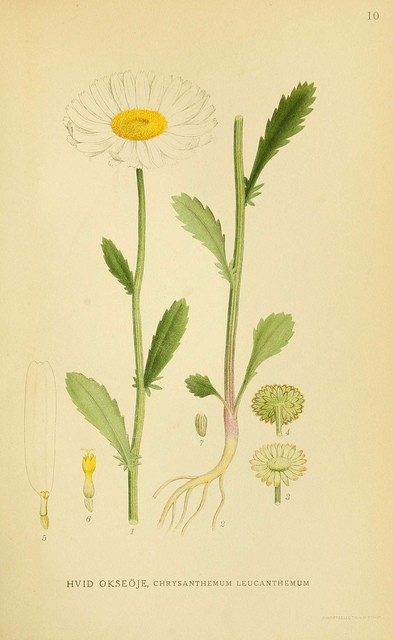
Leucanthemum vulgare – botanical illustration.
From a basal tuft of leaves 2 to 30 cm long gathered in a rosette, numerous leafy stems emerge in spring, deciduous and punctuated with entire, narrow, lanceolate, spatulate leaves, sometimes deeply lobed, with a regularly dentate edge. Measuring 10 to 30 cm, they are glossy, smooth, almost fleshy, and vary from bright green to dark green or grey-green. They are shorter towards the top of the stems and are arranged alternately.
From this vigorous and lustrous vegetation, whose interest lies mainly in its abundance, rise the graceful but sturdy floral stems that hold up well against the wind.
Radiant, the flowers of the Leucanthemum, this cousin of the sunflower, are like so many little stars with a sunny beauty.
From May to October, depending on the varieties (we distinguish between spring daisies, summer daisies, and even autumn daisies), the flower stalks bear terminal inflorescences in a solitary head measuring 2 to 12 cm in diameter.
Leucanthemums differ by the structure of the flowers, the shape, and the colour of the ligules. The heads are composed of a single or double collar of thread-like ligules, more or less numerous depending on the cultivar, surrounding a heart of tubular yellow or lemon-yellow florets.
While Leucanthemum vulgare or the common daisy has thin, flat white ligules, some varieties are characterised by a very double heart formed by an infinity of beautifully curled florets shaped like a fluffy pom-pom that gives the flower a rather extravagant appearance (‘Shapcott Ruffles’). Others bear strongly fringed ligules, with a frayed, feathery appearance, sometimes directed downwards, sometimes curled towards the sky.
Pure white for the most part – Leucanthemum in Latin and Greek means “white flower” – some daisies display a bright butter yellow colour, fading at maturity.
The flowering of daisies is of extraordinary generosity. It spans from spring to summer: the flowers renew continuously, attracting the flight of pollinating insects, sometimes until the gates of winter if faded flowers are regularly removed.
With their straight stems, they show excellent vase life and make beautiful simple and rustic summer bouquets.
A bit slow to establish, the daisy needs about two years to properly thicken, then it settles in and over time forms dense and very floriferous clumps. It reaches its full maturity in five years and can live for many years. Very easy to cultivate, this fully hardy perennial (down to -20°C) can adapt to many climates and can therefore be considered in most gardens in our regions. The daisy will give its best in the sun, in cool, fairly fertile ordinary soil, even calcareous, well-drained but not too dry.

Daisy flowers: Leucanthemum ‘Aglaia’, Leucanthemum ‘Luna’ (Copyright Terra Nova Nurseries), Leucanthemum ‘Victorian Secret’, Leucanthemum ‘Goldfinch’, Leucanthemum superbum ‘Wirral Supreme’.
With its simple, candid flowers, it allows for the creation of charming scenes in every corner of the garden, in the rustic flower beds of natural gardens, as well as in flowering meadows. It brings liveliness and lightness to borders, but also in cool rockeries.
The calming properties of its dried flowers are appreciated in infusions, much like chamomile.
Read also
Annual Rudbeckia: sowing, planting, careMain species and varieties
Si le genre Leucanthemum comprend 26 species annual or perennial, in our garden it is indeed Leucanthemum vulgare or Chrysanthemum leucanthemum, the large daisy with big single flowers that is the most widespread in our gardens. It has given rise to numerous hybrids (Leucanthemum x superbum, Leucanthemum maximum (x) superbum) which come in summer or autumn flowers, single, semi-double or double (‘Aglaïa’, ‘Etoile d’Anvers’…).
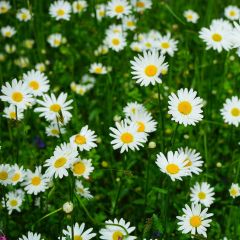
Leucanthemum vulgare Maikonigin
- Flowering time June, July
- Height at maturity 75 cm
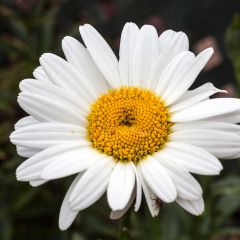
Leucanthemum superbum Becky - Shasta Daisy
- Flowering time July to September
- Height at maturity 80 cm
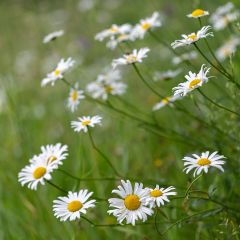
Leucanthemum vulgare
- Flowering time June to August
- Height at maturity 50 cm
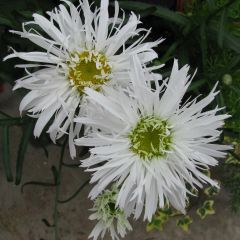
Leucanthemum superbum Aglaia - Shasta Daisy
- Flowering time August to October
- Height at maturity 65 cm
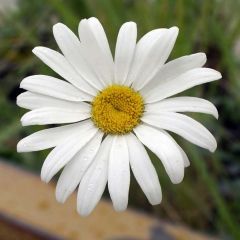
Leucanthemum superbum Etoile dAnvers - Shasta Daisy
- Flowering time July to October
- Height at maturity 80 cm
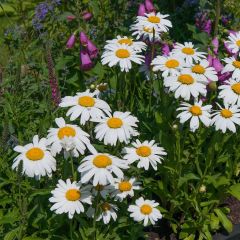
Leucanthemum Petite Princesse d'Argent - Shasta Daisy
- Flowering time August to October
- Height at maturity 30 cm

Leucanthemum superbum Banana Cream - Shasta Daisy
- Flowering time August to October
- Height at maturity 50 cm
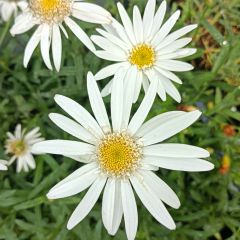
Leucanthemum superbum Christine Hagemann - Shasta Daisy
- Flowering time September, October
- Height at maturity 80 cm
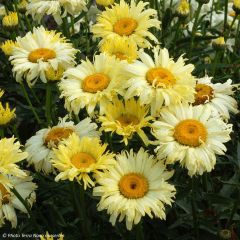
Leucanthemum superbum Goldfinch - Shasta Daisy
- Flowering time July to October
- Height at maturity 60 cm
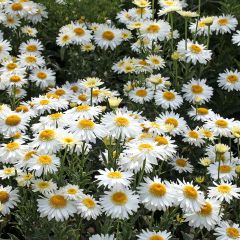
Leucanthemum superbum Real Glory - Shasta Daisy
- Flowering time July to October
- Height at maturity 70 cm
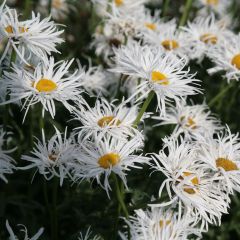
Leucanthemum superbum Shapcott Gossamer - Shasta Daisy
- Flowering time August to November
- Height at maturity 60 cm
Discover other Leucanthemum - Marguerite
View all →Available in 2 sizes
Available in 2 sizes
Available in 1 sizes
Available in 3 sizes
Available in 1 sizes
Available in 1 sizes
Available in 1 sizes
Available in 1 sizes
Available in 1 sizes
Available in 1 sizes
Planting
Where to plant Leucanthemum or daisy?
Very easy to grow, with a good hardiness (down to -15°C in well-drained soil), Leucanthemum thrives almost everywhere in France and adapts to all climates. Once well-rooted, it flourishes year after year, capable of self-seeding and even becoming invasive if the soil suits it.
It tolerates partial shade in the hottest regions, but will develop better in full sun sheltered from winds that may bend the stems of the taller varieties. Most large daisies need staking.
It is not very demanding regarding soil type. While it accepts any type of soil, even calcareous, as long as it is not too dry, it will reach its full potential in deep, fertile soil. The soil should be rich in organic matter to allow the daisy to bloom well. In poor soil, it will manage but its flowering may be less generous.
The daisy will perform best in well-drained soil that remains cool during summer, especially in the first few years. It will tolerate occasional drought better over time. It only fears excess water at its base: in very heavy soil, winter flooding can be fatal.
Versatile, it flowers in naturalistic beds, flower meadows beneath fruit trees or at the back of the garden, enlivens borders and lush mixed borders to which it brings real structure. Some dwarf varieties are ideal for decorating small spaces.
It even finds its place in countryside pots as well as in the vegetable garden for cut flowers.
When to plant daisies?
Planting daisies is done in spring in March and April in cold regions or in autumn in September-October elsewhere, outside of frost or drought periods.
How to plant Leucanthemum or daisy?
In the ground
To bloom well, the daisy appreciates rather rich soil: make a good addition of well-decomposed compost and improve drainage in heavy soils with some river sand.
Maintain a distance of 30 to 50 cm between plants depending on their adult size and count 3-5 buckets per m² for a beautiful effect in a bed. Daisies are used in large masses, either alone or mixed with other perennials.
- Prepare the soil well, removing roots of weeds and stones
- Place a layer of gravel at the bottom of the hole
- Plant by adding a bit of river sand and a handful of compost
- Mulch with pine bark to keep the soil cool during summer
- Water regularly after planting until established
- In spring, protect young shoots from snails and slugs
In a pot
- Place your daisy in a large pot in which you have previously laid a good layer of drainage (gravel or clay balls)
- Plant in a mix of 50% garden soil and 50% good potting soil
- Add a handful of ground horn
- Mulch and water very regularly without ever letting the substrate dry out, this is the guarantee of prolonged flowering
→ Learn more about planting and growing leucanthemum in pots in our advice sheet
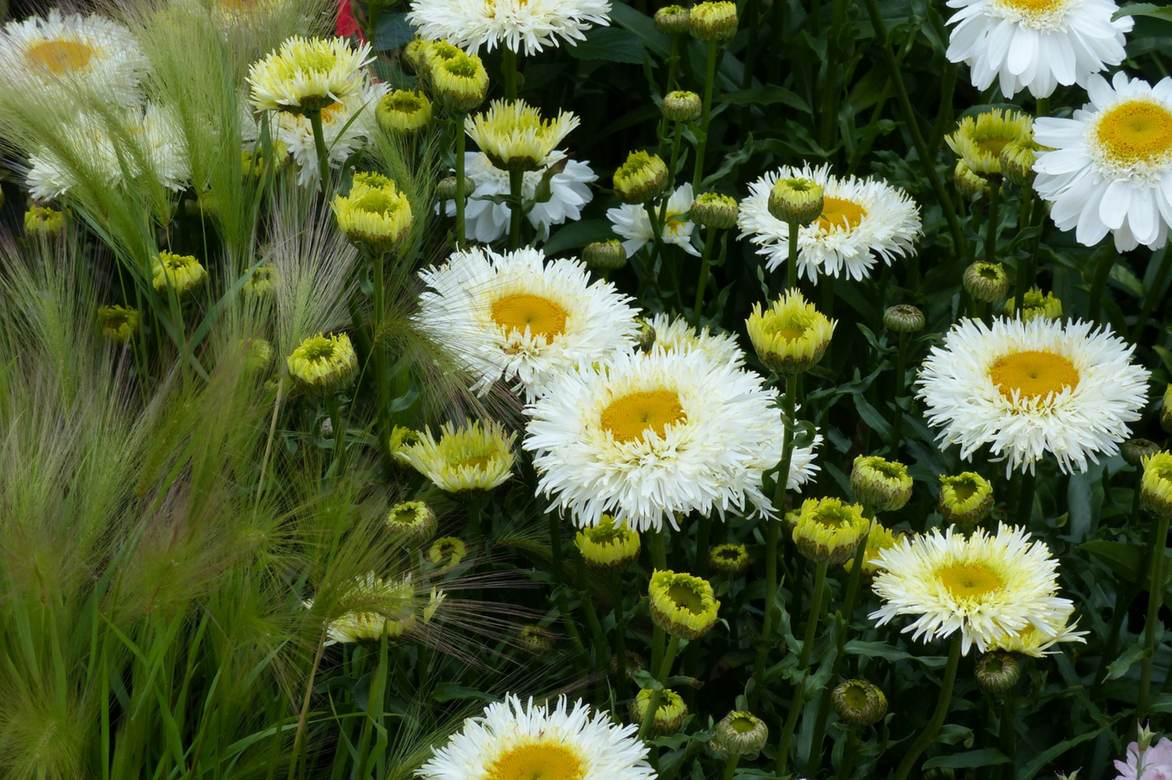
Leucanthemum and mohawk barley.
Read also
Echinaceas : sowing, growing and careMaintenance and care
In the ground
It is a very easy-to-grow perennial, low-maintenance. Its care is kept to a minimum. Once well established in full sun and well-drained soil, Leucanthemum manages on its own.
During the first spring and summer, water it regularly, especially during dry spells, but do not flood it: the base should remain cool. Afterwards, the plant will manage without watering, except during prolonged summer droughts.
Mulch in May to ensure the base remains sufficiently cool in summer.
A rather fertile soil promotes its flourishing: in spring, and then in mid-summer, add one or two shovelfuls of compost at the base of your leucanthemum.
Stake tall daisies if necessary, as they especially need it in windy areas.
Regularly remove faded flowers to encourage the appearance of new flower buds.
At the end of autumn, clean up the dead foliage and cut back the clump to 15 cm above the ground once it has blackened to promote branching and flowering, especially if it shows signs of weakness.
Every 4 to 5 years, in spring or autumn, divide the stumps if the plant shows signs of fatigue to rejuvenate it and regenerate the plants.
In pots
Allow the substrate to dry out between waterings. In winter, water every 10 days, without excess. Fertilise every 15 days, from May to September, with a special flowering plant fertiliser added to the watering water from May to September.
Diseases and potential pests
Never sick, the leucanthemum has few enemies.
From March, the daisies awaken and the first leaves appear: it is wise to protect them from slug appetites: use fern manure to combat their attacks. Discover our 7 effective and natural ways to combat slugs and how to make a slug trap.
Earwigs also enjoy its foliage; as useful as they are harmless, divert their attention by providing them with a nesting box: upturned flower pots filled with straw will do the trick nicely.
Daisies can be infested with aphids: spray with water mixed with 5% black soap.
The plant can sometimes be prone to leaf spots. Cut and dispose of the affected leaves. As a preventive measure, carry out regular sprays of horsetail or nettle decoction.
Propagating
Daisy multiplies easily by clump division at the end of winter, around March/April or after flowering. Practice daisy multiplication on mature clumps that are at least 4 or 5 years old.
- Using a forked spade, gently lift the clump
- Separate a few clumps from the periphery that have leaves and roots
- Replant these clumps immediately in the garden in well-prepared, fresh soil
Associating
With its tall and slender silhouette and its simple flowers, the Daisy is ideal for a country garden, in the style of a naturalistic meadow, even rivaling the grass. It is unmatched for creating wild-looking scenes with utmost simplicity.
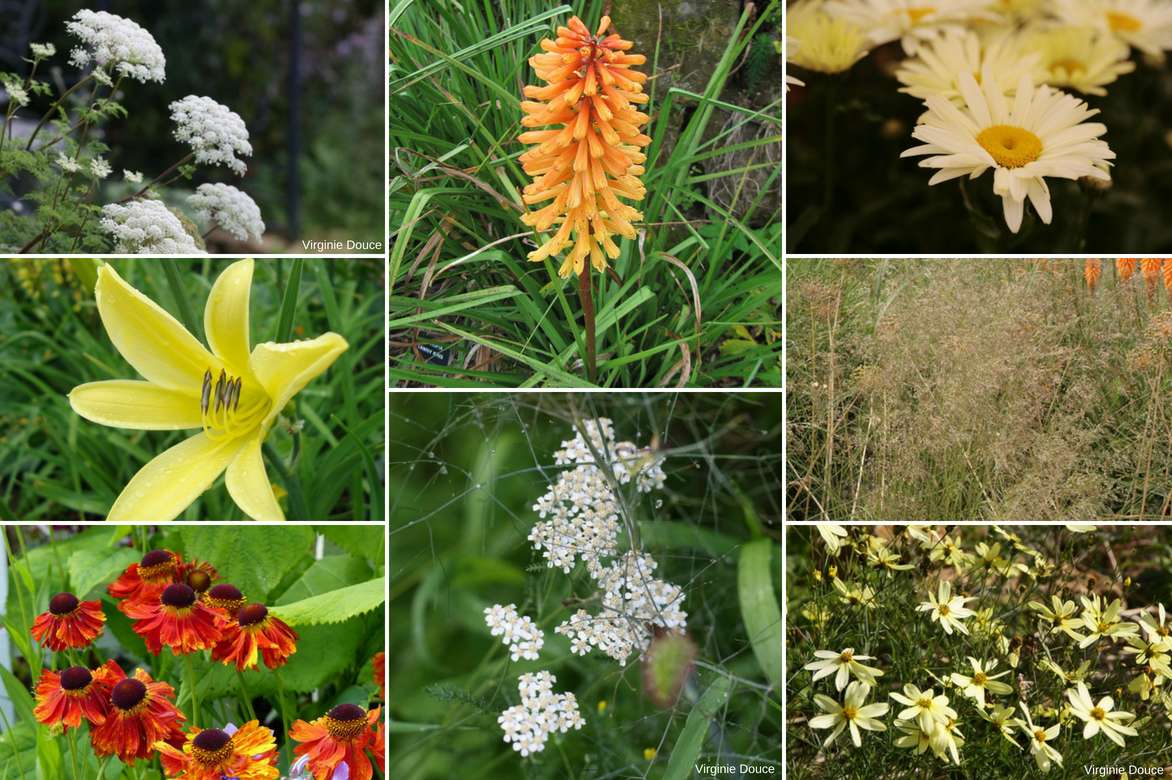
An example of a natural association with warm colours: Selinum wallichianum, Hemerocallis ‘Citrina’, Helenium ‘Moerheim Beauty’, Kniphofia ‘Tawny King’, Achillea millefolium ‘Heinrich Vogeler’ and Foeniculum vulgare ‘Giant Bronze’, Leucanthemum ‘Banana Cream’, Deschampsia cespitosa ‘Bronzeschleier’, Coreopsis verticillata ‘Moonbeam’.
It is the perfect plant for creating a naturalistic-inspired garden, mixed borders in the spirit of cottage gardens with other easy-to-grow and low-maintenance perennials.
In a meadow, it pairs pleasantly with wildflowers such as buttercup (Ranunculus acris), Lychnis, and Achillea millefolium, as well as Perennial honesty.
In more modern compositions, it combines well with graphic grasses like Tufted hair-grass and Pennisetums.
In a lush and flowery summer scene reminiscent of gardens of yesteryear, the flowering of summer daisies accompanies that of summer-flowering perennials or other cottage garden perennials such as Cosmos, columbines, asters, lupins, Echinops, Filipendula, campanulas, Coreopsis, Gaillardias, or Echinaceas, or snapdragons, for example. Lightly-habited perennials like Gaura or Gypsophila will add a sense of lightness as a counterpoint.
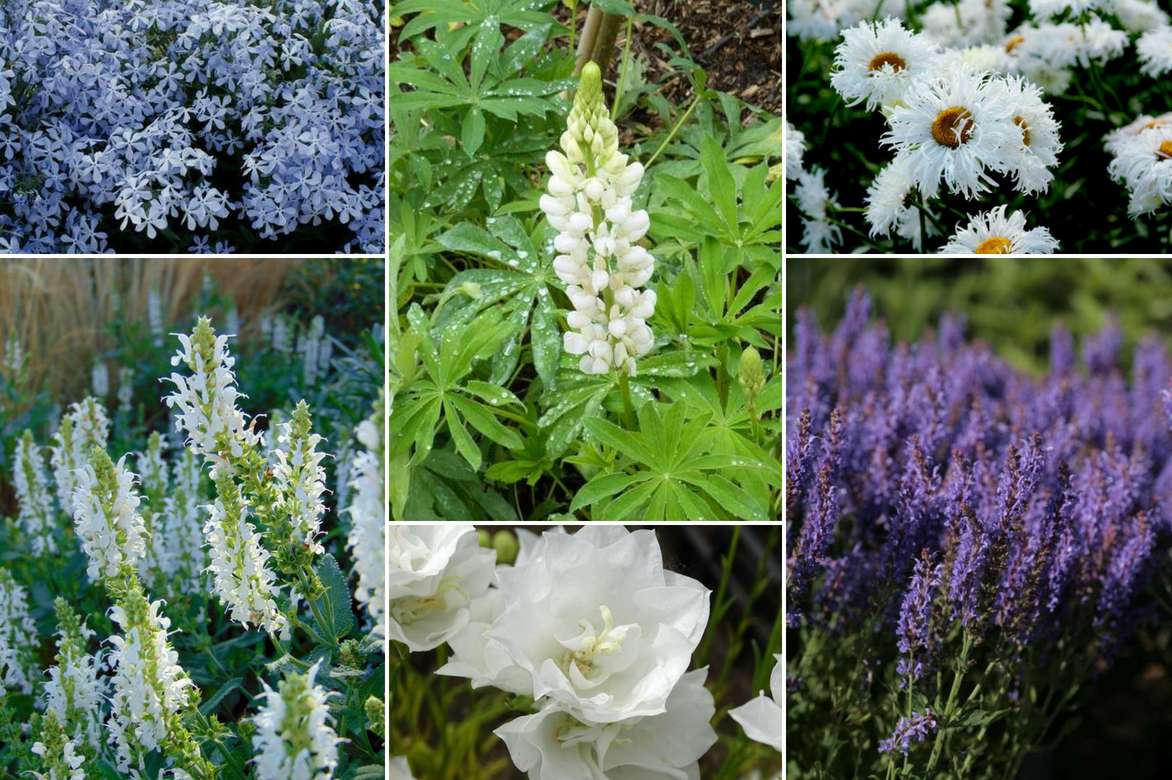
An idea for pairing: Phlox divaricata ‘Clouds of Perfume’, Salvia nemorosa ‘Schneehügel’, Lupinus ‘Gallery White’, Campanula persicifolia ‘Alba’, Leucanthemum ‘Shapcott Ruffles’, Salvia nemorosa ‘Blauhügel’.
In an impressive flowerbed, mix its sunny flowers with a backdrop of tall floral spikes from Bear’s breeches and Teasels.
The combination of white and silvery grey tones brings great softness to a summer bed: the large daisies, Penstemon, and Stachys will mingle in a joyful jumble that remains well-ordered nonetheless!
Full of poetry, its snow-white ligulate flowers are essential in romantic gardens surrounded by those of peonies and roses.
Autumn daisies pair well with large late perennials such as Boltonia, Helianthus, and large asters. They are also excellent companions for late-flowering roses, under which they create exuberant late summer scenes, or for shrubs with autumn colours such as serviceberries, sumacs, barberries, Callicarpa, deciduous azaleas, and cotinus.
A beautiful harmony is also possible with large eupatoriums, Actaea, and late aconites.
→ More pairing ideas with Leucanthemums in Christine’s advice sheet.
Useful resources
- What are you doing this weekend? How about counting the daisies?
- Daisies are perfect for a low-maintenance garden; discover which plants to pair them with for a country house vibe.
- The daisy is an essential plant in naturalistic gardens; get inspired by our ideas on our blog!
- Our advice sheet: Pairing Leucanthemums
- Subscribe!
- Contents
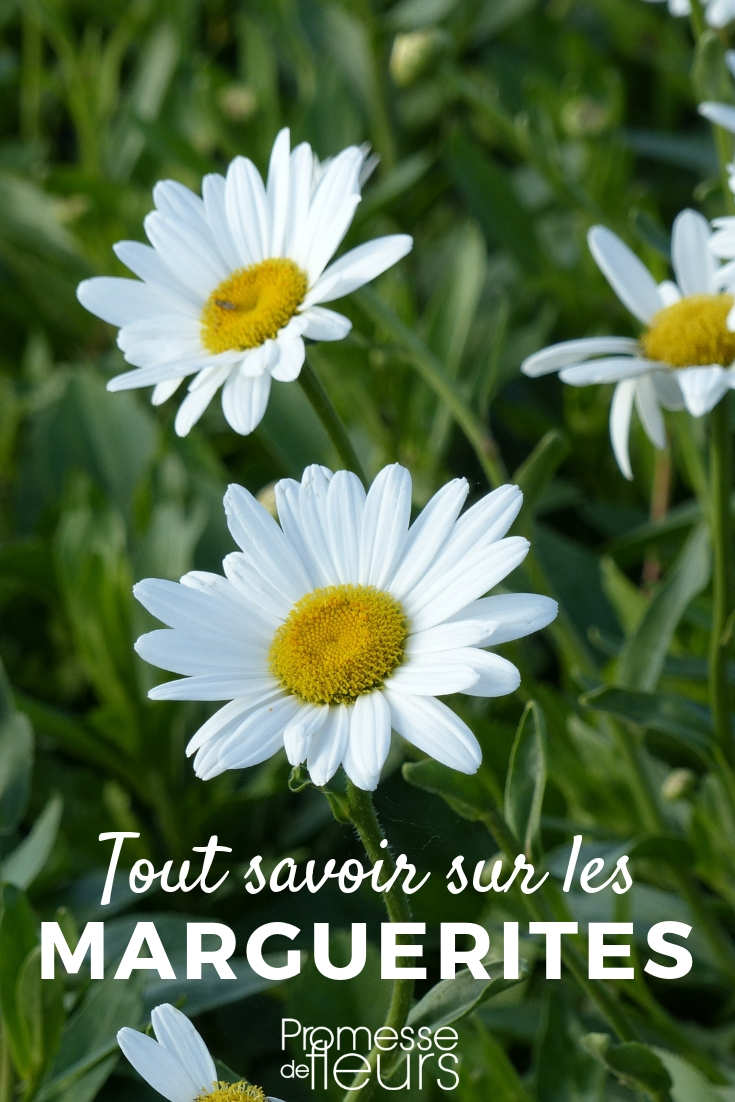


































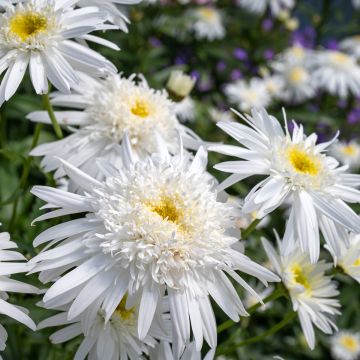
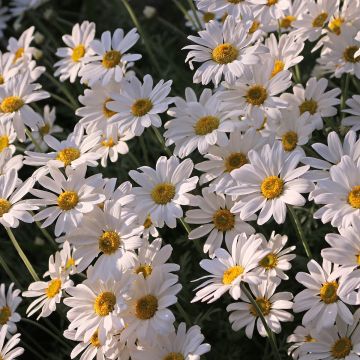

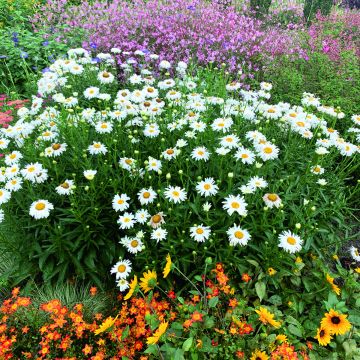

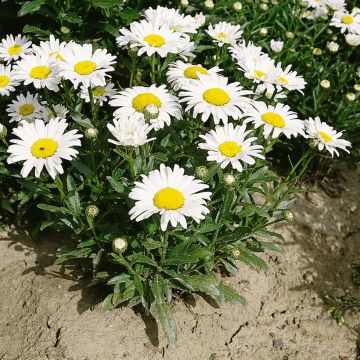
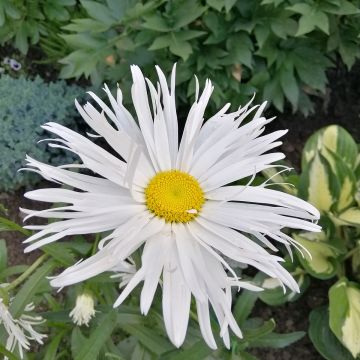
Comments